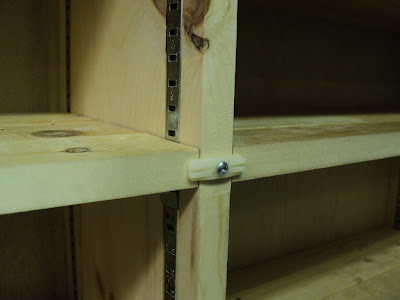One of the best ideas I've ever had for my small (300 sq. ft.) workshop was to mount machines on purpose-built shelving unit carts with casters. Here's a view of the one I made for my 9" band saw.
When the band saw is idle, I wheel it out to the rec room where it's out of my way. When I need the saw, I wheel it back into the shop and put it to use. The shelving underneath gives me much-needed storage space, and lets me keep the saw's accessories right with the saw.
The slightly out-rigged casters make the cart stable enough -- I don't find that the arrangement is at all 'tippy'; one would have to be trying in order to tip a cart. Following are some notes on the carts' construction.
Material
- For the frames and shelves, the cheapest stuff I could find -- nominal 1" x 10" x 8' pine shelving planks from Home Depot. It's pretty rude, crude stuff but it serves.
- For the back, 1/4" firply or RevolutionPly 5.2mm underlayment plywood. (I found the RevolutionPly product at Home Depot. It's ideal for the purpose, and the price is reasonable.)
- For the outriggers, 2" x 3" for 2" diameter casters; 2" x 4" for 3" diameter casters.
- Casters: Absolute minimum 2" diameter. Busy Bee has a set of four with brakes, Cat. No. B17862, for $9.99 CDN. Better to go with 3" diameter casters -- Busy Bee Cat. No. B17863, $15.99 for a set of four with brakes.
- Shelving support hardware: Knape & Vogt 255 Series steel standards (pilasters) and clips.
Simple butt joints at the corners, glued and screwed.
That's five No. 8 x 2" FH wood screws.I know that running screws into end-grain, as I've done here, is frowned upon in some circles, but it works fine -- my corner joints are quite sturdy.
The plywood back is simply glued and nailed on with finishing nails. I make the back slightly oversize, then flush trim it with a router.
Outriggers
For 2" diameter casters, I make the outriggers extend by 2". For 3" diameter casters, 3".
Shelving Pilasters
Set in 3/16" deep by 5/8" wide dadoes.
Lee Valley has the Knape & Vogt product. Home Depot and Canadian Tire carry a Rubbermaid equivalent that I advise against -- the Knape & Vogt product is superior, and about the same price. The Rubbermaid pilasters are poorly finished, and I've had a slot spacing defect in them once. I won't buy the Rubbermaid stuff again as long as I can get Knape & Vogt.
If shelves tend to 'walk'[1] or buzz because of machine vibration, a fix is to add 1/2" diameter inner-tube-rubber pads to the bearing faces of the clips. Here's a view of a bunch of clips that have had rubber pads added to them.
Cut the pads with a gasket cutter. Affix them to the clips with gelled CA adhesive.
Machine Attachment
Secure the machine to the top of the cart with suitable fasteners. Leaving a machine unsecured is not a good idea.
- - -
That about covers it. I've made five of these carts so far, and they're proving to be a very good thing for my workshop.
- - -
Note:
[1] Some machines are worse for this than others. A primitive wood lathe that I've mounted on a double-wide cart can really set shelves to 'walking', depending on lathe speed and how well balanced the item mounted in the lathe is. I came up with a quick-and-dirty solution in the form of nylon turn buttons installed on the cart's centre vertical divider, like so.
The turn buttons don't look too bad. The downside is that shelf relocation is complicated a bit by having to relocate a turn button as well.
# # #
# # #





No comments:
Post a Comment